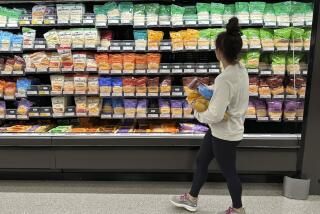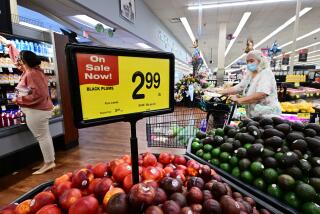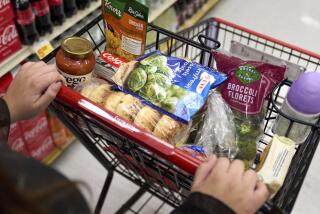Nervous about grocery shopping? Here’s how to get what you need faster

- Share via
One thing you can do to follow coronavirus guidelines (and to calm anxiety) while grocery shopping is to get in and out quickly and efficiently.
The precautions to take at the supermarket should focus on social distancing — the USDA notes that there is “no evidence of food or food packaging being associated with transmission of COVID-19” — as well as other measures like washing your hands frequently, using hand sanitizer and keeping your hands away from your face.
Coronavirus: Garcetti urges residents to wear face coverings when shopping, doing essential tasks
Supermarkets are also providing sanitizing wipes for your carts, limiting the number of shoppers in stores and in lines, and implementing special shopping times for seniors and pregnant women. Now is not the time to leisurely wander the market, pondering what you might want to make for dinner.
The approach I’ve been taking is the one I’ve trained test kitchen assistants over the years to practice: Before heading out, make a thorough list of everything needed according to where the items are located in the store and how they should be stacked in the cart; choose smart substitutes for anything you can’t find; and do it all as quickly as possible.
Years ago, one of my interns turned this exercise into a Supermarket Sweep-style race, trying to best his times with each trip. You can do the same using our fun shopping list as a guide. It’s sorted by supermarket aisles and the order items should go into the cart, going from the heaviest (bottled water, dishwashing soap) and items that won’t be damaged if crushed (bags of beans, sleeves of napkins) to stackable stuff (cans, cereal boxes, yogurt cartons, frozen foods) to fresh, with meat before produce. Bread can crown your carts, all the better to not get smushed.
Print out this list, fill it out and take it to the supermarket to make the trip quicker.
Check your supplies at home for general staples (salt, oil, coffee, paper towels, etc.). Assess how much space you have left in your cabinets and pantry, then list the essentials you need. Now, plan the types of meals you’d like to cook in the week ahead. If you have specific recipes in mind, bookmark those pages or print them. Add any ingredients you don’t have to your shopping list, then bring it and a pen to the market to cross off items as you snag them.
Once you’re at the store, swap anything that’s not on the shelves for a close substitute. No dried black beans? Try pinto instead. Beef case empty? Grab some lamb. Boxes of spring mix salads gone? Bag whole heads of lettuce.
Don’t worry about whether an ingredient will work in a recipe or linger in the aisle to Google what to do with what’s available. There’s plenty of time to scour the internet and cookbooks once you’re back home — and if you’re still stumped about what to do, you can email us at cooking@latimes.com or DM us on any of our social media channels.
Once you’re ready to check out, maintain that 6 feet of distance in line, then opt for contactless phone payment if that’s an option. After loading your trunk and returning your cart, you can use the sanitizing wipes by the carts to clean your hands.
Once home, organize all your goods and follow our tips for general kitchen cleanliness and washing produce before cooking.
Grocery essentials
If you’re new to cooking, here are some essential ingredients to have at home:
Cooking oil (olive or vegetable)
Salt
Spices (black pepper, crushed red chile flakes)
Liquid seasonings (vinegar, soy sauce, hot sauce)
Rice
Pasta/noodles
Whole grains (oats, farro, quinoa)
Dried and/or canned beans
Canned tomatoes and tomato paste
Canned tuna or other fish (sardines, anchovies)
Nuts or seeds
Dried fruit
Peanut butter or other nut or seed butters
Flour
Sugar
Baking powder and baking soda
Yeast
Frozen vegetables and fruits
Butter
Milk or dairy alternatives
Eggs
Onions and garlic
Root vegetables
Fresh fruit
Bread
More to Read
Eat your way across L.A.
Get our weekly Tasting Notes newsletter for reviews, news and more.
You may occasionally receive promotional content from the Los Angeles Times.












